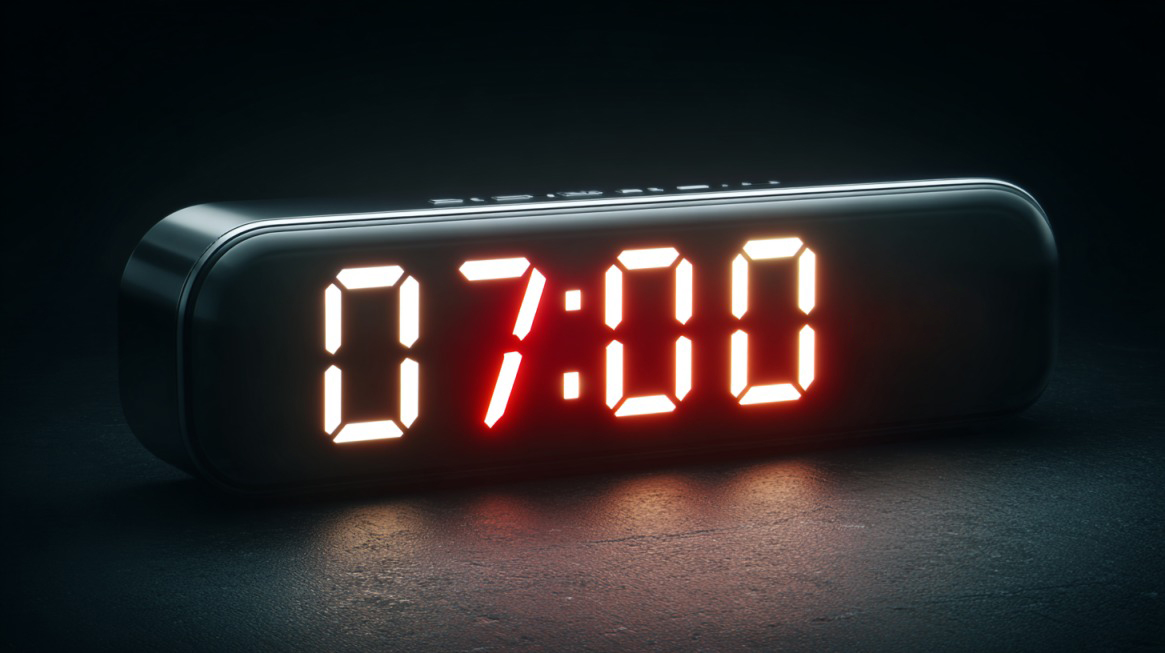A calm and focused mind doesn’t happen by accident. It’s built through small, repeatable habits that align your body clock, lower baseline stress, and prime your attention before the day accelerates.
Morning routines are about designing a short window that stabilizes your biology and sharpens your mental edge.
Let’s build that window step by step.
The First Hour Is Very Important
Your first hour sets the tone for the rest of the day. Cortisol peaks naturally after waking, and how you handle that window determines whether your mind settles into clarity or slides into distraction.
The goal is to let your body complete its natural wake cycle before flooding it with stimuli. Light, movement, hydration, and quiet reflection do the work that caffeine and urgency can’t.
A well-structured routine doesn’t need to exceed twenty minutes. What matters is that it runs in the same order every day. Repetition stabilizes your internal clock and lowers decision fatigue. You begin the day on your terms instead of reacting to outside input.
Step 1: Wake at a Consistent Time

Consistency is the foundation of mental stability. According to Harvard Health research, waking at the same time anchors your circadian rhythm, which regulates hormone cycles, mood, and alertness. Varying wake times by more than an hour confuses the body and leaves you sluggish.
Action
- Fix your wake time, seven days a week.
- Get outside within thirty minutes of waking.
- Spend ten to thirty minutes in natural light.
Even on cloudy days, outdoor light intensity far exceeds indoor levels. If winter darkness blocks natural light, use a 10,000-lux light box for twenty to thirty minutes. The light cues your brain to stop melatonin production and raises alertness naturally.
Step 2: Hydrate Before Coffee

After hours of sleep, your body wakes slightly dehydrated. MDPI study shows that even mild dehydration slows processing speed and dampens mood.
Water and nutrients before caffeine smooths the transition to wakefulness and prevents the jitters that come from coffee on an empty stomach.
Note: It is important to delay caffeine for the first 60 to 120 minutes after waking up!
Action
- Drink 300 to 500 ml of water immediately after waking.
- Add another glass after movement if you sweat.
Rehydration improves fatigue and working memory in controlled studies. It’s a low-effort lever with fast feedback: energy lifts, focus steadies, and digestion starts clean.
Step 3: Move for 5 to 20 Minutes

Movement wakes your nervous system faster than caffeine. It also improves long-term mood stability.
Studies show that exercise reduces anxiety and depressive symptoms, with effects matching some first-line treatments for mild depression.
You don’t need an hour-long workout; five to twenty minutes is enough to open blood flow and switch your brain into action mode.
Options
- 5 to 10 minutes of brisk walking.
- 8 to 12 bodyweight sets: squats, pushups, hip hinges, rows.
- 10 minutes of gentle yoga or mobility.
If mornings feel rushed, keep a mini routine ready by the door. Seven minutes of brisk stairs or dynamic stretches still counts.
Step 4: Slow Breathing or Mindfulness

Stress chemistry peaks in the early hours for many people. Two to ten minutes of calm breathing or mindfulness lowers cortisol and stabilizes focus.
Controlled trials show diaphragmatic breathing improves mood and cognitive flexibility, while mindfulness programs match prescription medications for anxiety reduction in some studies.
Action Options
- Slow breathing: Inhale through your nose for 4 seconds, exhale gently for 6 seconds. Continue for 2 to 5 minutes.
- Mindfulness block: Focus on the breath for 8 to 10 minutes, eyes open or closed. When your mind wanders, return attention to the breath.
Start small. Two minutes every day is more effective than sporadic long sessions.
If your stress levels still feel high despite morning adjustments, consider talking with a therapist who can help you build personalized coping tools.
Step 5: Keep Phones and News Away for 30 Minutes

The first thirty minutes after waking are when your brain’s attention networks reset. Flooding them with notifications hijacks focus before it stabilizes. Reducing early screen exposure improves sleep quality and lowers stress within weeks, as per a BioMed Central study.
Action
- Use a stand-alone alarm clock instead of your phone.
- Set “no notification” mode until after your breathing or planning block.
- Keep your phone in another room if possible.
Early quiet time strengthens the part of the brain that filters distractions. Over time, that translates into a more stable focus during work hours.
Many people suffer from phone addiction and have a hard time being without it. Read this guide on the most common addictions people face in the United States of America.
Step 6: Plan or Express Gratitude

The brain craves direction. A short planning or gratitude note steers your attention before distractions set in. Both practices have measurable effects on follow-through and stress regulation.
Action
- Planning: Write one top priority, two support tasks, and one obstacle with an “if-then” response.
- Gratitude: Write one sentence about something specific you appreciated yesterday.
Both formats work because they close open mental loops. Your mind stops spinning on what’s undefined and starts acting on what’s clear.
The 20-Minute Morning Template
| Minute | Activity | Purpose |
| 0–5 | Wake, open curtains, drink water, step outside | Light and hydration |
| 5–12 | Brisk walk or bodyweight work | Activate muscles and circulation |
| 12–17 | Slow breathing or mindfulness | Lower stress response |
| 17–20 | Write plan or gratitude note | Anchor attention |
| 60–120 min later | First coffee | Smooth alertness curve |
That’s it. Four anchors, twenty minutes, full reset.
Variants That Fit Different Lives
No two mornings look alike. Life rhythms differ, and routines must bend to fit them. The goal is not to copy a formula but to adapt the same principles: light, movement, breathing, and focus to your schedule.

If Mornings Are Frantic
- Keep a seven-minute movement routine ready.
- Do a two-minute breath set while boiling water.
- Write one top priority on a sticky note before leaving.
Short beats perfect. The brain prefers repetition to duration.
If You Commute
- Walk the first or last ten minutes of your route.
- Delay caffeine until arrival at work.
- Use commute time for slow breathing if you’re not driving.
If You Work Nights or Rotating Shifts
- Anchor your “wake time” before each shift block.
- Use a light box upon waking when outdoor light is unavailable.
- Dim lights before sleep and use blackout curtains.
- Keep caffeine cutoffs strict—eight hours minimum before sleep.
Shift work destabilizes circadian rhythm, but consistency in timing and light exposure still helps you maintain focus and mood.
For Breakfast, Keep It Simple

Breakfast is optional. What matters more is stability in timing and content. If you eat, choose foods that don’t spike blood sugar or cause sluggishness later.
Smart Options
- Greek yogurt with berries and walnuts.
- Eggs with vegetables and whole-grain toast.
- Oats with chia and a handful of nuts.
If you’re not hungry, skip it. Forcing food early can backfire if digestion is slow in the morning.
Secrets Behind Calm and Focus
Calm and focus aren’t personality traits but biological states. Both depend on how light, movement, breath, and routine influence your nervous system each morning.
| Topic | Description | Practical Tip |
|---|---|---|
| Light and Circadian Alignment | Morning light is a biological reset button. It tells your brain that the day has begun, advances your circadian rhythm, and lifts mood through serotonin activation. Bright light exposure within an hour of waking improves alertness and reduces the risk of seasonal affective symptoms. | Outdoor light, even on cloudy days, far exceeds indoor brightness. Step outside for at least ten minutes. If you live in a dark region, use a clinically certified light box rated at 10,000 lux. |
| Movement and Mood | Exercise is repeatedly shown to be one of the most effective nonpharmacologic treatments for depression and anxiety. Even moderate activity releases brain-derived neurotrophic factor (BDNF), which supports neuron growth and cognitive performance. | Aim for 7,000 to 8,000 steps most days. Morning movement locks in a baseline before the day’s schedule derails your intentions. |
| Breathing and Mindfulness | Slow breathing triggers the parasympathetic nervous system, reducing cortisol and heart rate. Mindfulness adds cognitive control by teaching you to notice attention drift and gently bring it back. | If meditation feels abstract, focus only on slow nasal breathing for two minutes. Count your exhales. That’s enough to begin calming your physiology. |
| Caffeine and Cortisol | Caffeine’s timing matters. Early caffeine stacks onto your cortisol surge, while delayed intake stabilizes energy levels. Over time, delaying your first cup can smooth the mid-morning slump. | Hydrate, move, and expose yourself to light first. Then have your coffee once natural alertness peaks. |
| Digital Boundaries | Your phone trains your attention like a slot machine. Limiting exposure early rewires the brain toward depth instead of reaction. Studies show even brief reductions in smartphone use improve sleep and lower depressive symptoms. | Leave the phone out of reach overnight. Use a basic alarm clock. The world can wait thirty minutes. |
| Planning and Gratitude | Planning gives structure; gratitude gives perspective. Both enhance focus and emotional balance. Writing one or two sentences is enough. The power lies in repetition. | Stick to the same form daily. The mind associates structure with safety, reducing anxiety through predictability. |
Sample Routines by Duration
View this post on Instagram
10-Minute Routine
- Light and water: 2 minutes
- Movement: 5 minutes
- Breathing: 2 minutes
- One-line priority: 1 minute
- Coffee later
20-Minute Routine
- Light and water: 3 minutes
- Movement: 7 minutes
- Mindfulness: 8 minutes
- Planning: 2 minutes
- Coffee later
30-Minute Routine
- Light and water: 5 minutes
- Jog or yoga: 10 to 15 minutes
- Mindfulness or breathing: 8 minutes
- Gratitude note: 1 minute
- Optional protein breakfast
- Coffee after one hour
Tip: If you’re a big lover of coffee even though you know all the disadvateges it comes with, I suggest you try Krakus Coffee. It is a healthier caffeine-free alternative to traditional coffee!
Each tier builds on the same four anchors: light, movement, breathing, and planning. Duration only changes intensity.
Resolving Common Issues
| Problem | Quick Fix |
| No morning light | Use a certified 10,000-lux light box for 20–30 minutes. |
| Persistent fatigue | Enforce an earlier bedtime and consistent wake time. |
| Morning stress | Avoid news, email, and social media until after breathwork. |
| No appetite | Skip breakfast or choose high-protein, low-sugar options. |
| Overwhelm | Reduce your routine to two elements: light and movement. Build back later. |
Perfection is unnecessary. Consistency is everything.
The Core Formula

- Consistent wake time anchored to natural light
- Short movement block to boost blood flow and mood
- Brief breathing or mindfulness to regulate attention
- Tiny planning or gratitude task to steer focus
Everything else: breakfast, caffeine, and journaling, is optional. The structure above can be completed in under twenty minutes and scales to any lifestyle.
Keep It Short, Keep It Repeatable
The strongest morning routines are not complex. They are tight, automatic, and repeatable under stress. A consistent twenty-minute block does more for mental clarity than any supplement or app. The goal is not to perfect mornings, but to remove uncertainty from them.
Wake at the same time. Step into the light. Move. Breathe. Plan. Then, and only then, reach for the coffee.

